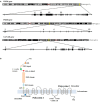The Genetic and Cellular Basis of Autosomal Dominant Polycystic Kidney Disease-A Primer for Clinicians
- PMID: 29326913
- PMCID: PMC5741702
- DOI: 10.3389/fped.2017.00279
The Genetic and Cellular Basis of Autosomal Dominant Polycystic Kidney Disease-A Primer for Clinicians
Abstract
Autosomal dominant polycystic kidney disease (ADPKD) is one of the most common genetic disorders worldwide. In recent decades, the field has undergone a revolution, starting with the identification of causal ADPKD genes, including PKD1, PKD2, and the recently identified GANAB. In addition, advances defining the genetic mechanisms, protein localization and function, and the identification of numerous pathways involved in the disease process, have contributed to a better understanding of this illness. Together, this has led to a better prognosis, diagnosis, and treatment in clinical practice. In this mini review, we summarize and discuss new insights about the molecular mechanisms underlying ADPKD, including its genetics, protein function, and cellular pathways.
Keywords: autosomal dominant polycystic kidney disease; diagnosis; genetics; molecular biology; therapy.
Figures


References
Publication types
LinkOut - more resources
Full Text Sources
Other Literature Sources
Miscellaneous

